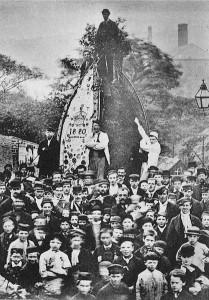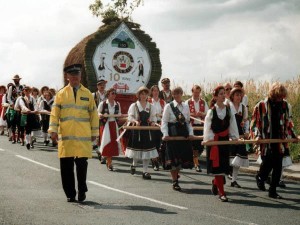Rush-bearing

Seats were not provided in church until the 15th century and even if the floors were flagged the excessive cold after long standing and the kneeling required during devotions necessitated the floor being covered.
The renewal of the rushes at the church commonly coincided with the Saint’s Day to which the church was dedicated and the corresponding “Wake,” the custom quickly developed into a part of the religious festival.
Originally it seems to have been the practice for the parishioners to carry the rushes to church in bundles. As the custom became more of a festival, these were ornamented, and were then borne by young men and maidens dressed in their best attire, and bearing flowers to decorate the church.
This method prevailed all over the country, but in South-East Lancashire a far more elaborate arrangement grew up. The rushes, which at one time had been brought to church on sledges, formed into the shape of a haystack, were placed in a cart (often with a man riding it), and the ingenuity of the people soon made this into an exceedingly novel and pleasing spectacle.
Village vied with village in the beauty and size of their rush-carts; rivalry led to expensive ornaments; music and morris dancers followed, till the rush-bearing became a pageant.
As the use of rushes for covering the floor died out, the custom continued in these areas.
A description of one rush cart from around 1860:-
” In front of the inn stood the rush-cart, which, to our southern readers, may require a more detailed description. One of the larger carts, used in Lancashire either to carry manufactured goods or to bring harvest from the field, had been heaped with rushes to the height of about twenty-four feet from the ground, The rushes were skilfully arranged into a perfectly smooth conical stack, rising to a sharp ridge at the top. From this centre four hedges, formed of rushes woven into a neat pattern, and each hedge about two feet high, descended to the four corners of the cart. On the summit was a bower in the form of a crown, made of holly, laurel, and other evergreens, round which were twined garlands. An immense wreath of large flowers encircled the base of the arbour, and a smaller one decorated its top. On each of the smooth sides of the cone, between the boundary of rush-hedges, were inscriptions in brilliantly-coloured flowers, such as “Colliers and Weavers,” “Fear God,” “Honour the King,” etc. Spangled flags of various bright hues hung from the sides of the crowning bower. A large silver salver from the Hall, with some silver tankards, hung on the front. About thirty young men, with white shirts down to the waist, profusely adorned with gay ribbons, and with wreaths of flowers on their heads, were yoked in couples between two strong new ropes. Each couple held a stave fastened on either side into a knot in the rope, and they were engaged in practising some dances, with which their entry into the principal streets of Rochdale was to be celebrated.
By the late 18th century there were eight or nine rush carts in Rochdale with a donation of five shillings given to the first to arrive at the parish church. This led fierce rivalries and often stout battles between rival processions (including one where the “featherer” of the Marland cart – the person who forms and cuts the rushes on the cart – was shot dead).
Such drunkenness and violence led to the practice eventually being forbidden in the town!
The industrial Revolution provided the final nail in the coffin for the custom with the birth of the railways the mill towns would empty at Wakes as it became popular to use the new conveyance to visit the seaside during this holiday.
Rush-bearing ceremonies have survived, or been revived, in a number of towns and villages in northwest England including: Gorton, Littleborough, and Saddleworth in Greater Manchester, Newchurch in Pendle in Lancashire, Sowerby Bridge in Yorkshire, and Ambleside, Great Musgrave, Grasmere, Urswick and Warcop in Cumbria.



Pingback: Gordon Batty Collection – St. Chad’s Parish Church, Rochdale. | Folk Customs